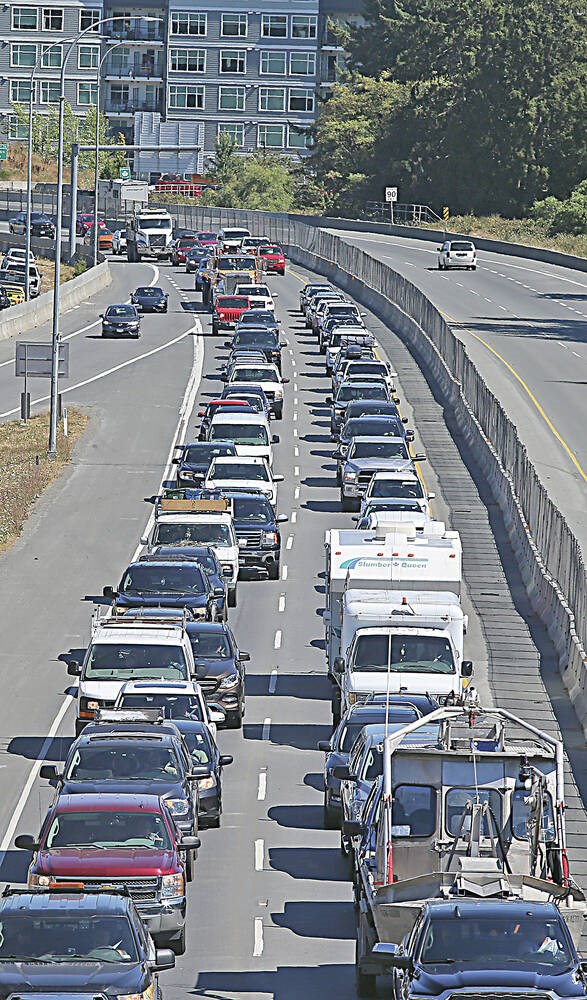After writing this column for a while now, I’ve received tons of feedback from readers. I’m very grateful that most of it is very positive. That means a lot to me.
With nearly every compliment, though, there’s a caveat, which goes something like this: “Enjoy your column … keep up the good work … great advice … but…”
The “but” is nearly always about how, despite my astute advice and keen insight, it’s not having much effect on drivers out there. People consistently tell me the driving environment today in this region is the worst they’ve known.
I looked at ICBC figures for the past few years and concluded that this perception about the poor quality of drivers on our roads is not showing up in the stats.
We average about 278,000 crashes each year in this province. That’s down from a high of 316,000 in 2018. Things declined during COVID but have ticked up slightly since restrictions were lifted.
Likewise, “casualty crashes,” as ICBC calls them, averaged about 54,000 per year, with high points of about 65,000 in 2018 and 2019 followed by a COVID drop and then a similar uptick in 2020 and 2021.
Despite the stats, there’s a loss of both basic driving civility and attention happening on our roads.
Here’s my take.
Population increases are putting more and more cars on the roads and increasing driver frustration.
We made a quick trip to Barkerville a couple of weeks ago. Of course, I’m using the Canadian definition of “quick.” It was a return trip of 1,600 km. That’s nearly the same as driving through France — north to south — and back again.
It was that stretch of the Trans-sa国际传媒 Highway between Langley and Abbotsford, a testament to urban congestion at its worst, that offered up the greatest challenge on our route. Closer to home, our piece of the Trans-sa国际传媒 on either side of the Malahat is often as bad at times.
It’s easy to see that once clear of these bottlenecks, stifled drivers vent their frustration via the gas pedal — with 120 to 130 km/h speeds being common.
More driver distraction is happening out there. Studies in the U.S. find that the multitude of in-car convenience features and new layers of technology are not making us safer.
I’ve had friends admit to me that when taking hands-free phone calls in their cars, they can’t remember the driving part of their journey.
Multitasking, be it fiddling with climate controls, taking phone calls or finding a song, makes it impossible for the brain to be completely focused on the road. Add to that, chomping on a sandwich or fixing your hair makes it even more likely you’re going to offend others on the road.
Vehicle-safety engineers realize that more is not necessarily better. Some manufacturers are rethinking their work — focusing on how drivers behave rather than layering on more and more techie doodads.
High-profile traffic enforcement has waned steadily in the past few years. Tighter budgets and the inability to attract new officers have required police departments to cut back on proactive traffic measures and move more toward a general call-response model.
Studies I’ve mentioned in the past show that the most effective model to promote traffic-rule compliance is a combination of education and enforcement. Without that check and balance system on our roads, scofflaws rise, affecting road safety for the rest of us.
The economy is playing a role in poorer driver behaviour. There is more pressure on commercial drivers especially to do more and do it faster.
For example, we saw commercial drivers, in rigs of various sizes, plowing into overpasses throughout the Lower Mainland this past year. Simply not taking time to be aware of (or ignoring) the height of these rigs caused major disruptions and danger to others on the road.
But I also see it with delivery drivers who block driveways and park on boulevards as they run house to house with their packages.
Finally, there is a steady increase in other types of vehicles using our roads. While it’s natural to examine other ways to get around on crowded streets, there’s only so much drivers can contend with.
E-bikes, electric scooters, electric unicycles, unicycles and electric tricycles are filling up road space so quickly that law and policy-makers can’t keep up. Drivers are nervous.
One traffic safety pundit says we must redouble education efforts to a wartime level of urgency, similar to what we did to combat smoking.
The readers I meet believe there’s lots to be concerned about. I agree. While stats say we are keeping road deaths and injuries relatively level, despite all of these issues, those numbers, and the behaviours causing them, should never be accepted as normal.
>>> To comment on this article, write a letter to the editor: [email protected]



